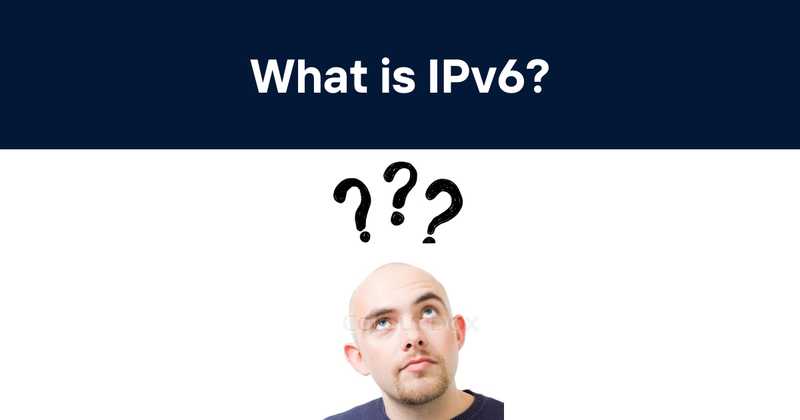What is IPv6?
IPv6 (Internet Protocol version 6) is the most recent version of the Internet Protocol, designed to address the limitations of its predecessor, IPv4. As a software developer, understanding IPv6 is crucial for building modern, future-proof applications and services. This comprehensive guide will explore the key aspects of IPv6, its benefits, and how it impacts development practices.
Table of Contents
- Introduction to IPv6
- Key Features of IPv6
- IPv6 Address Structure
- IPv6 Address Types
- Comparison with IPv4
- IPv6 Deployment and Adoption
- Dual-Stack Networking
- IPv6 in Application Development
- Security Considerations
- IPv6 Testing and Troubleshooting
- Future of IPv6
Introduction to IPv6
IPv6 was developed by the Internet Engineering Task Force (IETF) to address the impending exhaustion of IPv4 addresses. With the explosive growth of internet-connected devices, the limited address space of IPv4 (approximately 4.3 billion unique addresses) became insufficient to meet global demand.
IPv6 introduces a vastly larger address space, along with improvements in routing, network autoconfiguration, and security. As a developer, embracing IPv6 ensures your applications can operate seamlessly in modern network environments and reach the growing number of IPv6-only clients.
Key Features of IPv6
Understanding the key features of IPv6 is essential for developers working on network-aware applications:
-
Expanded Address Space: IPv6 uses 128-bit addresses, providing approximately 3.4 × 10^38 unique addresses. This vast pool eliminates the need for Network Address Translation (NAT) and allows for true end-to-end connectivity.
-
Simplified Header Format: The IPv6 header is more efficient than its IPv4 counterpart, with fewer fields and a fixed size of 40 bytes. This streamlines packet processing and improves overall network performance.
-
Improved Support for Extensions and Options: IPv6 handles packet header options more efficiently, allowing for easier introduction of new features without impacting the core protocol structure.
-
Built-in Security: IPsec, which provides encryption and authentication at the IP layer, is a mandatory component of IPv6. This built-in security enhances the overall safety of network communications.
-
Better QoS (Quality of Service) Support: IPv6 includes features for improved traffic prioritization, which is particularly beneficial for real-time applications like VoIP and video streaming.
-
Stateless Address Autoconfiguration (SLAAC): This feature allows devices to automatically configure their IP addresses without the need for a DHCP server, simplifying network administration.
IPv6 Address Structure
IPv6 addresses consist of 128 bits, typically represented as eight groups of four hexadecimal digits, separated by colons. For example:
To simplify the representation of IPv6 addresses, two shorthand notations are commonly used:
-
Leading Zero Suppression: Within each group of four hexadecimal digits, leading zeros can be omitted. For example:
2001:db8:85a3:0:0:8a2e:370:7334 -
Zero Compression: A double colon (::) can replace a single contiguous string of one or more groups of zeros. This can be used only once in an address. For example:
2001:db8:85a3::8a2e:370:7334
Understanding these notation rules is crucial for developers working with IPv6 addresses in their applications.
IPv6 Address Types
IPv6 defines several types of addresses, each serving a specific purpose:
-
Unicast Addresses: These identify a single network interface. They are further categorized into:
- Global Unicast Addresses (similar to public IPv4 addresses)
- Link-Local Addresses (for communication on a single network segment)
- Unique Local Addresses (for local communications within a site or organization)
-
Multicast Addresses: Used to send a single packet to multiple destinations simultaneously.
-
Anycast Addresses: Assigned to multiple interfaces, typically on different nodes. A packet sent to an anycast address is delivered to the nearest interface identified by that address.
-
Special Addresses: Including the unspecified address (::) and the loopback address (::1).
As a developer, you should be familiar with these address types to properly handle different network scenarios in your applications.
Comparison with IPv4
While IPv6 builds upon the foundation of IPv4, it introduces several significant changes:
| Feature | IPv4 | IPv6 |
|---|---|---|
| Address Length | 32 bits | 128 bits |
| Address Notation | Dotted-decimal | Hexadecimal |
| Header Size | Variable (20-60 bytes) | Fixed (40 bytes) |
| Checksum | Included in header | Removed from header |
| Fragmentation | Allowed by routers and sending hosts | Only allowed by sending hosts |
| ARP | Used for address resolution | Replaced by Neighbor Discovery Protocol |
| ICMP | Separate protocol | Integrated (ICMPv6) |
| Security | Optional (IPsec) | Mandatory |
| QoS Support | Limited | Enhanced (Flow Label field) |
These differences have important implications for network programming and application design. Developers need to account for these changes when adapting existing IPv4 applications or creating new IPv6-compatible software.
IPv6 Deployment and Adoption
The transition to IPv6 has been gradual but steady. Major internet service providers, content delivery networks, and technology companies have been deploying IPv6 infrastructure to support the growing demand for IP addresses and to future-proof their networks.
As a developer, it's important to be aware of the current state of IPv6 adoption:
- Many mobile networks now use IPv6 as their primary protocol.
- Major cloud providers offer full IPv6 support.
- Operating systems and web browsers prioritize IPv6 connections when available.
- Some regions, particularly in Asia, have seen rapid IPv6 adoption due to the scarcity of IPv4 addresses.
To ensure your applications reach the widest possible audience, it's crucial to support both IPv4 and IPv6. This is typically achieved through dual-stack networking, which we'll explore in the next section.
Dual-Stack Networking
Dual-stack networking is a transition mechanism that allows IPv4 and IPv6 to coexist on the same network infrastructure. In a dual-stack environment, devices are assigned both IPv4 and IPv6 addresses and can communicate using either protocol.
For developers, implementing dual-stack support in applications involves several considerations:
-
Name Resolution: Applications should be able to handle both A (IPv4) and AAAA (IPv6) DNS records.
-
Socket Programming: Use protocol-agnostic APIs like
getaddrinfo()for address resolution andsockaddr_storagefor storing socket addresses. -
Connection Attempts: Implement "Happy Eyeballs" algorithm to quickly establish connections over either IPv4 or IPv6, whichever responds faster.
-
User Interface: When displaying IP addresses or allowing user input, support both IPv4 and IPv6 formats.
-
Configuration: Allow users to specify preferences for IPv4 or IPv6 when applicable.
Here's a simple example of a protocol-agnostic socket connection in Python:
for res in socket.getaddrinfo(host, port, socket.AF_UNSPEC, socket.SOCK_STREAM):
af, socktype, proto, canonname, sa = res
try:
sock = socket.socket(af, socktype, proto)
except socket.error:
sock = None
continue
try:
sock.connect(sa)
except socket.error:
sock.close()
sock = None
continue
break
if sock is None:
print('Could not connect to server')
return None
return sock
# Usage
sock = connect_to_server('example.com', 80)
if sock:
# Use the socket for communication
sock.close()
This code snippet demonstrates how to create a socket connection that works with both IPv4 and IPv6 addresses.
IPv6 in Application Development
When developing applications with IPv6 support, consider the following best practices:
-
Use Protocol-Agnostic APIs: Leverage libraries and functions that abstract away the differences between IPv4 and IPv6.
-
Handle Larger IP Addresses: Ensure that your data structures and databases can accommodate the longer IPv6 addresses.
-
Update Validation Logic: Modify any input validation or parsing code to handle IPv6 address formats.
-
Review Network-Related Code: Examine all areas of your application that deal with networking, including configuration files, logging, and user interfaces.
-
Test with IPv6: Set up IPv6 test environments and include IPv6 scenarios in your testing plans.
-
Consider IPv6-Only Environments: Design your applications to function correctly in networks where only IPv6 is available.
-
Update Documentation: Revise user guides and API documentation to include IPv6-related information.
Here's an example of how to update a simple web server to support both IPv4 and IPv6 in Python:
import socket class DualStackHTTPServer(HTTPServer):
def server_bind(self):
# Enable dual-stack support
self.socket.setsockopt(socket.IPPROTO_IPV6, socket.IPV6_V6ONLY, 0)
return super().server_bind()
if name == 'main':
server_address = ('::', 8000) # '::' binds to all available interfaces
httpd = DualStackHTTPServer(server_address, SimpleHTTPRequestHandler)
print(f'Serving on http://[{server_address[0]}]:{server_address[1]}')
httpd.serve_forever()
This server will listen on both IPv4 and IPv6 interfaces, allowing clients to connect using either protocol.
Security Considerations
While IPv6 includes built-in security features like IPsec, developers must still be vigilant about security when working with IPv6:
-
Larger Address Space: The vast IPv6 address space makes traditional IP scanning techniques less effective, but also complicates network monitoring and intrusion detection.
-
New Attack Vectors: IPv6-specific features like Neighbor Discovery Protocol (NDP) introduce new potential vulnerabilities that developers and network administrators must address.
-
Transition Mechanisms: Dual-stack and tunneling technologies used during the IPv4 to IPv6 transition can create security loopholes if not properly configured.
-
Privacy Extensions: IPv6 includes privacy extensions that generate temporary addresses, which can complicate user tracking and logging.
-
Firewall Rules: Ensure that firewall rules are updated to accommodate IPv6 traffic and new ICMPv6 message types.
-
End-to-End Connectivity: The removal of NAT in IPv6 networks means that devices are potentially directly accessible from the internet, requiring careful security design.
When developing IPv6-aware applications, implement robust input validation, use secure coding practices, and stay informed about IPv6-specific security threats and mitigations.
IPv6 Testing and Troubleshooting
Thorough testing is crucial for ensuring that your applications work correctly with IPv6. Here are some key areas to focus on:
-
Connectivity Testing: Verify that your application can establish connections over IPv6 and handle various network scenarios.
-
Dual-Stack Behavior: Test how your application behaves in dual-stack environments, ensuring it can seamlessly use both IPv4 and IPv6.
-
Address Handling: Confirm that your application correctly processes and displays IPv6 addresses in all relevant parts of the user interface and logs.
-
Performance Testing: Compare the performance of your application over IPv4 and IPv6 to identify any significant differences.
-
Error Handling: Verify that your application gracefully handles IPv6-related errors and fallback mechanisms.
For troubleshooting IPv6 issues, familiarize yourself with these tools:
ping6andtraceroute6: IPv6 versions of common network diagnostic tools.ipcommand: A powerful tool for configuring and troubleshooting network interfaces on Linux systems.- Wireshark: A network protocol analyzer that can capture and analyze IPv6 traffic.
- Web-based IPv6 test tools: Online services that can help you verify your IPv6 connectivity and configuration.
Future of IPv6
As the internet continues to grow and evolve, IPv6 will play an increasingly important role in connecting devices and services. Developers should stay informed about emerging trends and technologies related to IPv6:
-
Internet of Things (IoT): The massive number of IoT devices requires the expanded address space of IPv6.
-
5G and Beyond: Next-generation mobile networks rely heavily on IPv6 for their architecture.
-
Cloud Native Applications: Modern cloud environments are embracing IPv6 for improved scalability and simplified network management.
-
IPv6-Only Networks: Some organizations and service providers are moving towards IPv6-only infrastructures to reduce complexity and costs.
-
New Protocol Development: Future internet protocols and standards are being designed with IPv6 in mind, potentially leading to new capabilities and optimizations.
By embracing IPv6 in your development practices now, you'll be well-positioned to take advantage of these future developments and create applications that are truly ready for the next generation of the internet.



